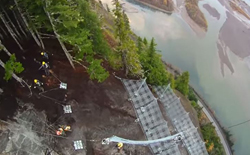Avalanche Safety Program
Our avalanche safety program keeps our roads and travellers safe. Staff constantly monitor conditions, and if the risk of an avalanche is too great, we will close and evacuate the highway until the danger is past. We begin regularly assessing avalanche hazard in the mountain snowpack from November through May in British Columbia.
British Columbia's avalanche safety program was developed to:
- Ensure the safety of all highway users
- Minimize the frequency and duration of avalanche related road closures
Avalanches occur naturally when the bonds that hold the winter snowpack together break from additional stresses created by weather factors such as rain, wind, rising temperatures and/or the weight of new or wind drifted snow.
Avalanche technicians are stationed at eight key locations around the province, maintaining a constant watch over weather and snowpack conditions in 62 avalanche prone areas. They use information from a sophisticated network of weather stations along with avalanche observations and snowpack investigations to determine if avalanches are likely to occur. When conditions indicate that avalanches may occur, the highway is temporarily closed to ensure public safety.
Closures remain in effect until the snowpack regains stability through further change in weather conditions or through avalanche activity. During these closures, the avalanche technician may be able to use explosive devices to artificially trigger an avalanche. The most common method of avalanche blasting is to deploy explosives from a helicopter into avalanche zones.
Avalanche control devices have been installed on the mountainside at several critical locations. These devices can be remotely fired by avalanche technicians, allowing avalanche blasting to proceed in adverse weather conditions that would prevent the use of helicopters.
In other locations, structures have been built to reduce or eliminate the effect of avalanches, including snowsheds, arresting mounds or walls, diversion dikes, catchment basins or nets to hold snow in place in start zones of avalanche paths.
Useful Links
Contact information
Contact us if you have questions about the Avalanche Safety Program.


